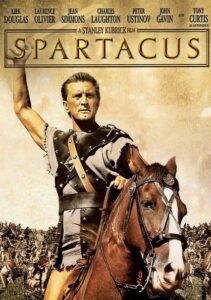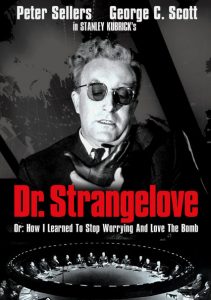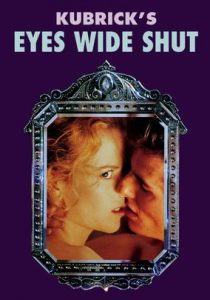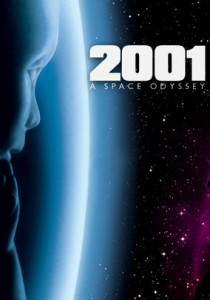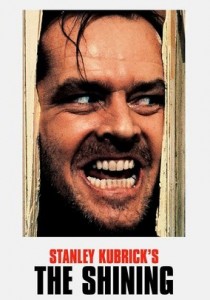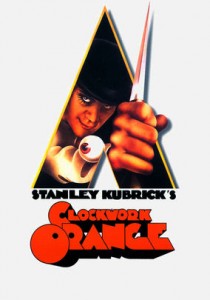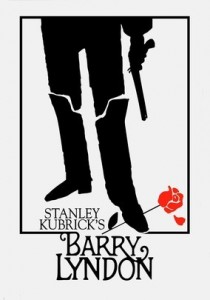Spartacus-1960
Director Stanley Kubrick
Starring Kirk Douglas, Laurence Olivier, Jean Simmons
Scott’s Review #1,250
Reviewed April 30, 2022
Grade: A
Typically, when influential director Stanley Kubrick’s name is uttered, films such as The Shining (1980), 2001: A Space Odyssey (1968), and Barry Lyndon (1975) are immediately thought of, and for obvious reasons.
The haunting, moody musical score, the long camera shots, the dark humor, and the clever camera tricks are easy to pinpoint.
Rewinding to 1960, the director was brought in to grab the reigns and direct the gorgeous epic, Spartacus, after Hollywood star Kirk Russell had unceremoniously fired the first director.
None of the previously mentioned elements are easy for me to notice and are more or less absent, but a grand battle scene in a luscious green field is very reminiscent of Barry Lyndon. This is likely because Spartacus was not Kubrick’s film entirely instead it belonged to others with more clout.
Throwing out the director issues, Spartacus is a brilliant film for many reasons. Some epics suffer from a hokey, cliched feel and can be overwrought, predictable, and tired.
The rebellious Thracian Spartacus (Russell), born and raised a slave, is sold to Gladiator trainer Batiatus (Ustinov). After training to kill for the arena, Spartacus turns on his owners and leads the other slaves in rebellion.
As the rebels move from town to town, their numbers increase as escaped slaves join their ranks. Under the leadership of Spartacus, they make their way to southern Italy, where they intend to cross the sea and return to their homes.
Spartacus is grand, sweeping, cinematically great, and everything else you’d expect from a 1960s Hollywood epic with enormous stars of its day. Looking beneath the surface, the film is riddled with interesting tidbits like bisexuality, homoeroticism, and violence more in tune with an art film or modern war film than the safety of a film made during this time.
Particularly noteworthy is that Dalton Trumbo wrote the screenplay. One of the Hollywood Ten, he refused to testify before the House Un-American Activities Committee in 1947 during the committee’s investigation of alleged Communist influences in the motion picture industry.
After the release of Spartacus, it marked the beginning of the end of the Hollywood Blacklist for Trumbo and other affected screenwriters.
Thank goodness.
In a famous scene, recaptured slaves are asked to identify Spartacus in exchange for leniency; instead, each slave proclaims himself to be Spartacus, thus sharing his fate.
The suggestion is that this scene was meant to dramatize the solidarity of those accused of being Communist sympathizers during the McCarthy era.
Besides the political importance, Spartacus also showcases a beautiful romance between Spartacus (Russell) and Varinia (Jean Simmons), a gorgeous slave girl. The tenderness and authenticity are palpable as many of their early scenes involve no dialogue but only longing and expression through both actors’ eyes.
I celebrated the connection between the actors who are at the forefront of much romance. Russell carries the film with a calm, masculinity that easily makes him heroic and likable.
He is the charismatic good guy who has been wronged and ill-fated.
A sequence oozing with machismo and homoeroticism occurs when evil Crassus (Olivier) is bathed by his slave boy Antoninus (Tony Curtis). He seductively explains that while sometimes he prefers snails, he also likes oysters too. The implication is that he is bisexual, brazenly so, and expects the youngster to become his sex slave.
The warmth of the bathtub and the luxurious atmosphere are juxtapositioned against the proximity and touch of both male characters.
In 1960, this scene was way ahead of its time.
The conclusion of Spartacus is melancholy and surprising. The expectation might have been to happily see Spartacus and Varinia ride off into the sunset having bested the cruelty of Rome.
This doesn’t happen and the film is all the richer for it. There is pain and despair as there were in real life. Wisely sparing complete doom and gloom, the ending is satisfying as one major character is allowed to escape a deadly demise and conjure ahead with their life.
Spartacus (1960) is one of the greats. It has muscle, texture, and many below-the-surface nuances ripe for discussion. It’s a must-see for many reasons.
Oscar Nominations: 4 wins-Best Supporting Actor-Peter Ustinov (won), Best Art Direction-Color (won), Best Cinematography-Color (won), Best Costume Design-Color (won), Best Film Editing, Best Music Score of a Dramatic or Comedy Picture
